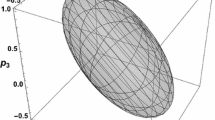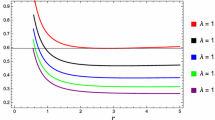Abstract
Analytic gravitational collapse and expansion solutions with anisotropic pressure are generated. Metric functions are found by requiring zero heat flow scalar. It emerges that a single function generates the anisotropic solutions. Each generating function contains an arbitrary function of time which can be chosen to fit various astrophysical time profiles. Two examples are provided: a bounded collapse metric and an expanding cosmological solution.


Similar content being viewed by others
References
Misner, C.W., Sharp, D.H.: Spherical gravitational collapse with energy transport by radiative diffusion. Phys. Lett. 15, 279 (1965)
Herrera, L., Ospino, J., Di Prisco, A.: All static spherically symmetric anisotropic solutions of Einstein’s equations. Phys. Rev. D 77, 027502 (2008)
Herrera, L., Santos, N.O., Wang, A.: Shearing expansion-free spherical anisotropic fluid evolution. Phys. Rev. D 78, 084026 (2008)
Bowers, R.L., Liang, E.P.T.: Anisotropic spheres in general relativity. Astrophys. J. 188, 657 (1974)
Cosenza, M., Herrera, L., Esculpi, M., Witten, L.: Some models of anisotropic spheres in general relativity. J. Math. Phys. 22, 118 (1981)
Bayin, S.S.: Anisotropic fluid spheres in general relativity. Phys. Rev. D 26, 1262 (1982)
Bondi, H.: Anisotropic spheres in general relativity. Mon. Not. Roy. Astr. Soc. 259, 365 (1992)
Viaggiu, S.: Modeling usual and unsual anisotropic spheres. Int. J. Mod. Phys. D 18, 275 (2009)
Dev, K., Gleiser, M.: Anisotropic stars: exact solutions. Gen. Relativ. Gravit. 34, 1793 (2002)
Dev, K., Gleiser, M.: Anisotropic stars: exact solutions and stability. Int. J. Mod. Phys. D13, 1389 (2004)
Mak, M.K., Harko, T.: Anisotropic stars in general relativity. Proc. Roy. Soc. Lond. A 459, 393 (2003)
Sharma, R., Tikekar, R.: Non-adiabatic radiative collapse of a relativistic star under different initial conditions. Pramana J. Phys. 79, 501 (2012)
Barceló, C., Liberati, S., Sonego, S., Visser, M.: Fate of gravitational collapse in semiclassical gravity. Phys. Rev. D 77, 044032 (2008)
Herrera, L., Santos, N.O.: Local anisotropy in self-gravitating systems. Phys. Rep. 286, 53 (1997)
Glass, E.N.: Shear-free collapse with heat flow. Phys. Lett. 86A, 351 (1981)
Mars, M., Senovilla, J.M.M.: Geometry of general hypersurfaces in spacetime: junction conditions. Class. Quantum Grav. 10, 1865 (1993)
Collins, C.B.: Global structure of the ’Kantowski-Sachs’ cosmological models. J. Math. Phys. 18, 2116 (1977)
Kantowski, R., Sachs, R.K.: Some spatially homogeneous anisotropic relativistic cosmological models. J. Math. Phys. 7, 443 (1966)
Geller, M.J., Diaferio, A., Kurtz, M.J.: The mass profile of the Coma galaxy cluster. Astrophys. J. 517, L23 (1999)
Barrow, J.D., Maartens, R.: Anisotropic stresses in inhomogeneous universes. Phys. Rev. D 59, 043502 (1998)
Taub, A.H.: Stability of general relativistic gaseous masses and variational principles. Commun. Math. Phys. 15, 235 (1969)
Herrera, L., Di Prisco, A., Ospino, J.: Conformally flat anisotropic spheres in general relativity. J. Math. Phys. 42, 2129 (2001)
Senovilla, J.M.M.: Trapped surfaces, horizons and exact solutions in higher dimensions. Class. Quantum Grav. 19, L113 (2002)
Penrose, R.: Gravitational collapse and space-time singularities. Phys. Rev. Lett. 14, 57 (1965)
Acknowledgments
We thank Professor Jean Krisch for constructive comments.
Author information
Authors and Affiliations
Corresponding author
Appendix: Energy-momentum and physical components
Appendix: Energy-momentum and physical components
Metric
is Petrov type D. The two principal null vectors, normal to (\(\vartheta ,\varphi \)) two-surfaces, are
The energy-momentum tensor is given by (\(G=c=1\))
where \(p_{r}\) is the radial pressure, \(p_{\perp }\) is the tangential pressure, \(w\) is the mass-energy density, and \(q^{\mu }\) is the radial heat flow vector orthogonal to \(\hat{u}^{\mu }\). We use notation of Taub [21] for \(w\). Taub’s purpose was to distinguish mass-energy density from proper mass-density \(\rho \), with \(w=\rho (1+\epsilon )\). This allows the first law of thermodynamics to be written in its usual form \(Tds=d\epsilon +pd(1/\rho )\) with specific entropy \(s\) and specific internal energy \(\epsilon \). The kinematics of the fluid are described by
where primes denote \(\partial /\partial r\), and overdots denote \(\partial /\partial t\). The rate-of shear \(\sigma _{\mu \nu }\) is trace-free, and \(\sigma _{\mu \nu }\sigma ^{\mu \nu }=6\sigma ^{2}\). The heat flow vector (\(q^{\mu }\hat{u}_{\mu }=0\)) is given by
The sectional curvature mass is
The mass-energy density and pressures are given, respectively, by
1.1 Trapped surfaces
The topological two-spheres (\(\vartheta ,\varphi \)) nested in an \(R=const\) surface at time \(t\) have outgoing null geodesic normal \(l^{\mu }\) and incoming null geodesic normal \(n^{\mu }\). The two principal null vectors (46) and (47) provide trapping scalars
When scalars [23] \(\kappa _{1}\) and \(\kappa _{2}\) have the same sign, a trapped surface [24] will exist:
Rights and permissions
About this article
Cite this article
Glass, E.N. Generating anisotropic collapse and expansion solutions of Einstein’s equations. Gen Relativ Gravit 45, 2661–2670 (2013). https://doi.org/10.1007/s10714-013-1609-7
Received:
Accepted:
Published:
Issue Date:
DOI: https://doi.org/10.1007/s10714-013-1609-7




